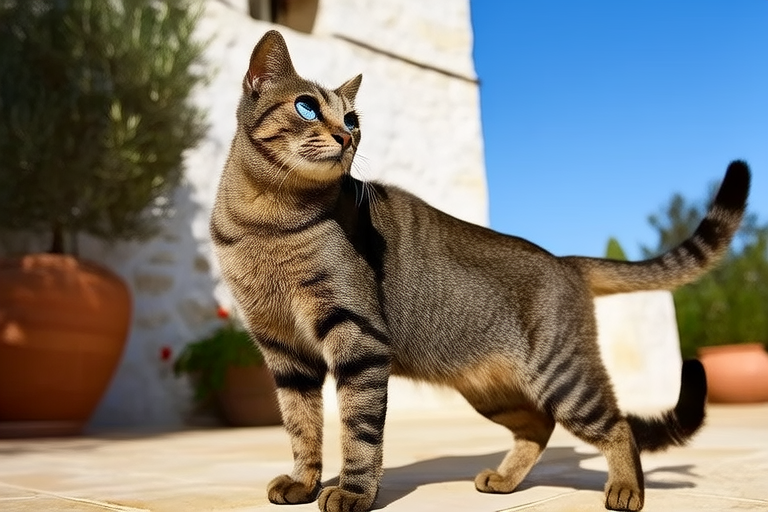The Enduring Legacy of the Turkish Angora Cat
The Turkish Angora is a breed of cat with a rich history that dates back thousands of years, rooted deeply in the heart of Anatolia. This elegant and graceful feline has not only been a beloved companion but also holds significant cultural and mythological importance in Turkey.
Historical Origins
The Turkish Angora originates from the region of Ankara, formerly known as Angora, in central Anatolia. The breed’s history is intertwined with the area’s ancient civilizations, including the Hittites, who once inhabited the land. Historical records suggest that the Turkish Angora was already a well-established breed during the Ottoman Empire era. These cats were highly valued and often gifted to foreign dignitaries as symbols of friendship and goodwill.
Cultural and Mythological Significance
In Turkish culture, the Turkish Angora is more than just a pet; it is a symbol of elegance and grace. The breed’s striking appearance and regal demeanor have made it a favorite subject in Turkish art and literature. Moreover, the Turkish Angora has played a role in Turkish mythology, where it is believed to possess magical powers and the ability to ward off evil spirits. Legends tell of these cats guarding sacred places and ensuring the safety of their human companions.
Physical Traits and Temperament
The Turkish Angora is known for its long, silky coat and large, expressive eyes that can be blue, green, or gold. Their body structure is slender yet muscular, giving them a graceful and athletic appearance. They have a medium-sized frame, with males typically being larger than females. The most distinctive feature of the Turkish Angora is its tail, which is long and plumed, adding to its overall elegance.
When it comes to temperament, the Turkish Angora is an intelligent and playful breed. They are known for their affectionate nature and enjoy interacting with their human companions. However, they can also be independent and may require mental stimulation to prevent boredom. Turkish Angoras are generally good with children and other pets, making them ideal family pets. Their curiosity and agility make them excellent hunters, and they will often bring small prey to their owners as gifts.
Globally Recognized Breed
The Turkish Angora gained international recognition in the early 20th century when it was introduced to the United States and Europe. Initially, the breed was rare and sought after by cat enthusiasts due to its unique appearance. However, the Turkish Angora faced challenges in preservation efforts. During World War II, many breeding programs were disrupted, leading to a decline in the number of purebred Turkish Angoras.
Efforts to preserve the breed were initiated by the Ankara Zoo in Turkey, where a dedicated breeding program was established. The zoo played a crucial role in maintaining the purity of the Turkish Angora by carefully selecting breeding pairs and documenting each generation. Today, the Turkish Angora is recognized by major cat registries worldwide, including the International Cat Association (TICA) and the Fédération Internationale Féline (FIFe).
Famous Turkish Angoras
Throughout history, several Turkish Angoras have gained fame for their unique traits or roles. One notable example is Muezza, a Turkish Angora who was reportedly owned by Prophet Muhammad. According to legend, Muezza was so beloved that the Prophet Muhammad once cut off his sleeve rather than disturb the cat while it was sleeping on his robe. Another famous Turkish Angora is Saffy, a cat who lived in the White House during the presidency of George W. Bush. Saffy was known for her playful and affectionate nature and became a popular figure among the staff and visitors at the White House.
Caring for a Turkish Angora
Prospective owners of Turkish Angoras should be prepared for a high-maintenance breed that requires regular grooming and attention. Their long, silky coats need daily brushing to prevent matting and tangling. Additionally, Turkish Angoras are prone to certain health issues, such as hypertrophic cardiomyopathy, a type of heart disease. Regular veterinary check-ups and a balanced diet are essential for maintaining the health of these cats.
Owners should also provide their Turkish Angoras with plenty of mental and physical stimulation to keep them engaged and happy. Interactive toys, climbing structures, and puzzle feeders are all great options for keeping these curious and intelligent cats entertained. Furthermore, Turkish Angoras thrive in environments where they can interact with their human companions, so owners should be prepared to spend quality time with their pets.
Enduring Legacy
The Turkish Angora has left an indelible mark on the world of cat breeds and continues to be cherished by cat lovers around the globe. Its rich history, cultural significance, and unique physical and behavioral traits make it a truly special breed. In modern times, the Turkish Angora remains a symbol of elegance and grace, embodying the spirit of its homeland. As the breed continues to evolve and adapt to changing times, its legacy will undoubtedly endure, ensuring that future generations will continue to admire and appreciate this magnificent feline.
